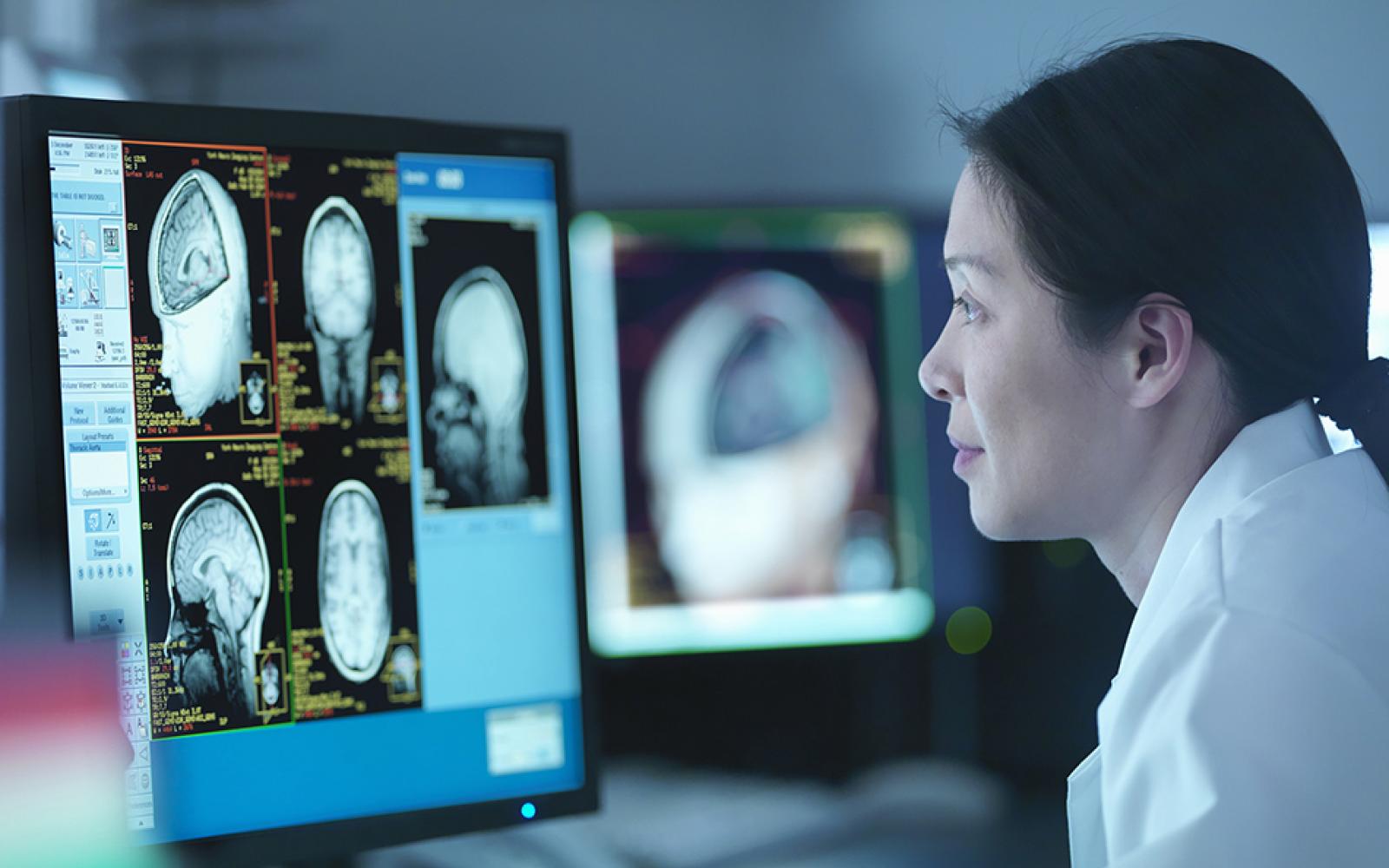
Glioblastoma
Glioblastoma is a highly malignant brain tumor that arises from astrocytes, which are supportive cells in the nervous system.
Astrocytes are responsible for various roles, including providing nutrients to neurons, maintaining the blood-brain barrier, and modulating neurotransmission (how neurons communicate with each other).
Glioblastomas often develop in the cerebral hemispheres of the brain but may occur in almost any area of the brain or spinal cord. They are especially malignant, given that the tumor cells proliferate quickly and are frequently supported by an extensive network of blood vessels.
Glioblastomas are the most malignant type of astrocytoma and belong to the broader category of gliomas – tumors that arise from glial cells. This is because astrocytes are a type of glial cell. For this reason, glioblastomas may also be called grade 4 gliomas.
Many common symptoms of glioblastoma result from an increased pressure in the brain. This occurs as the tumor grows larger and takes up space, compressing healthy brain tissue within the fixed volume of the skull. Tumors can also grow large enough to block the normal flow of cerebrospinal fluid in the brain, which can also cause a buildup of pressure. Swelling around the tumor can further contribute to this increased pressure in the brain. Symptoms related to increased intracranial pressure include the following:
- Headaches
- Nausea
- Vomiting
- Double vision
- Confusion or change in mental status
More specific symptoms depend on the location of tumor, and the functions affected. For example, glioblastoma that occur near the motor cortex (the part of the brain involved in body movement) may cause loss of movement or sensation on one side of the body. Tumors near the language regions of the brain may cause problems with speech.
Glioblastomas are the most common primary brain malignant tumor and account for about 13.9% of all primary brain tumors.1 Between 2017 and 2021, physicians diagnosed an average of 13,073 cases per year in the United States.1 Glioblastomas only occur in adults2, with the median age at diagnosis being 65 years old.1
The World Health Organization now classifies brain tumors primarily based on their molecular features. Specifically, glioblastomas do not have mutations in the IDH1 or IDH2 genes and thus are called IDH-wildtype.2 A neuropathologist also needs able to see the formation of new blood vessels (microvascular proliferation) or dead cells (necrosis) upon examining a sample of the tumor tissue under the microscope. If these histological features are not present, a glioma can be classified as a glioblastoma if it has mutations in the promoter region of the TERT gene, alterations in the EGFR gene, or abnormalities in chromosomes 7 and 10.
Glioblastoma is a primary (or de novo) type of brain tumor. Lower-grade gliomas do not progress or transform into glioblastomas, according to the WHO’s current classification scheme.1
Patients with glioblastoma are usually first treated with surgery. The primary goals of surgery are the following:
- Collect a tissue sample for diagnosis
- Remove as much of the tumor as possible, while protecting critical brain function (this is called “maximal safe resection")
- Alleviate symptoms caused by the tumor
Glioblastoma can occur in or near areas of the brain that control body movement, sensation, or language, so special measures may be taken to protect these functions. Awake surgery with brain mapping is commonly used when tumors are located in the brain regions that control language or movement. This technique allows surgeons to safely identify and preserve critical brain regions.
Because glioblastomas tend to spread into neighboring healthy tissue, it can be difficult to fully remove all malignant cells during surgery. This means, that for adult patients, surgery is usually followed by radiation therapy and chemotherapy to target and slow the growth of remaining tumor cells. Typically, conventional external beam radiation is given over the course of several weeks. Certain other radiotherapy techniques like Gamma Knife and IMRT, may be used as additional radiation therapy, and offer the ability to specifically target remaining tumor cells while reducing radiation exposure to healthy tissue. For newly diagnosed glioblastoma, temozolomide is typically the chemotherapy drug that complements radiation treatment. In very young children (under 3 years old), standard treatment includes surgery and chemotherapy. These younger patients usually do not tolerate radiation very well. In some cases, clinicians may be able to use radiotherapies like Gamma Knife that specifically target the tumor site and minimize radiation exposure to the rest of the brain. Tumor-treating fields (TTFields) may also be a treatment modality that patients with newly diagnosed glioblastoma could consider to help slow tumor growth.
Neurocognitive rehabilitation is also available through our Neurocognitive Care Services. Our multi-disciplinary team will assess each patient's needs, and devise an individualized plan to improve language, motor, or cognitive impairments caused by the brain tumor.
Glioblastoma is a serious condition that will be treated by a multidisciplinary team consisting of neurosurgeons, oncologists, and radiation oncologists. How well a patient with glioblastoma responds to treatment depends on a variety of factors, including the tumor’s size, location, and amount remaining after surgery. Other important factors include the patient’s age and overall health.
Over time, glioblastomas almost always recur (grow back). Patients are regularly monitored for tumor recurrence, and treated as needed. Additional surgery and radiation may be considered for recurrent glioblastoma, depending on the patient’s overall condition. There are also a range of experimental therapies, outside of standard care, that may be available through participation in clinical trials.
The primary goal of treatment is to not only prolong survival for patients, but also to increase a patient’s quality of life, by addressing neurological symptoms and preserving cognitive function.
Finding information about specific prognoses and survival rates is a personal decision. The current statistics are only summary data and do not necessarily reflect results from new or experimental therapies. These data do not determine how individual patients might respond to their treatment – everyone is different. That said, some people may choose to look for this information, which can be found in the most recent CBTRUS Statistical Report in Tables 15-18.1 Patients may also find it helpful to discuss this information with their neuro-oncologist.
- Price, M. et al. (2024). CBTRUS Statistical Report: Primary Brain and Other Central Nervous System Tumors Diagnosed in the United States in 2017-2021. Neuro-oncology, 26(Supplement_6), vi1–vi85.
- Louis, D. N., et al (2021). The 2021 WHO Classification of Tumors of the Central Nervous System: a summary. Neuro-oncology, 23(8), 1231–1251.
Surgical Specialists
This content was reviewed by UCSF neuro-oncologist Jennifer Clarke, MD, MPH.










